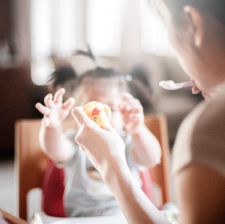New parents are faced with a lot of new experiences and decisions that need to be made. Upon birth a new parent must decide whether  or not to breast feed or bottle feed. Then when the infant reaches approximately six months of age, decisions must be made regarding solid foods; homemade or store bought? This lesson invites students to explore the pros and cons of each type of baby food and then experiment and compare homemade and store bought versions of the same food in a lab comparison activity.
or not to breast feed or bottle feed. Then when the infant reaches approximately six months of age, decisions must be made regarding solid foods; homemade or store bought? This lesson invites students to explore the pros and cons of each type of baby food and then experiment and compare homemade and store bought versions of the same food in a lab comparison activity.
Time Frame: 3 Class Periods (43 minutes)
Class Size: 12
PA Standards
- 11.3.12 F Evaluate the application of nutrition and meal planning principles in the selection, planning, preparation and serving of meals that meet the specific nutritional needs of individuals across the lifespan.
- 11.4.12 B Analyze current issues in health and safety affecting children at each stage of child development.
- 11.4.12 C Analyze practices that optimize child development (e.g., stimulation, safe environment, nurturing caregivers, reading to children).
Set
- Introduce the lesson by showing students the following props: a bib, baby spoon and small bowl. Ask students what they mean or symbolize in the stage of a baby’s life, what they might actually put in the bowl (foodwise) and why.
- Follow with a Pre-Writing & Thinking activity using this clip on Starting Your Baby on Solids.
- Props or Powerpoint pictures of props
- Projector & SMARTBOARD
- Created Padlet Walls
- Store Bought Baby Food and Produce for Homemade Versions ( Ex. Carrots & Apples)
Activities
- Count students off by three’s and individually read assigned articles and create a list of 3-4 positives and negatives about each homemade and store bought baby foods based on information contained in article. Article #1: How to Make Your Own Baby Food, Article #2: Homemade or From the Jar: Which Baby Food is Best? and Article #3: Homemade vs Store Bought Baby Food–Which is the Healthiest?
- Then form small groups of 3 (each group member with a different article) and compare/contrast lists making a group list of pros and cons for each type of baby food based on all their articles.
- Create one Padlet wall entitled Homemade Baby Food: Good Idea/Bad Idea and one Padlet wall entitled Store Bought Baby Food: Good Idea/Bad Idea on the former site known as Wall Wisher where students will add their lists for each food type and label by group number and it’ll be projected onto a screen. After each type is posted with positives and negatives, students will create a master chart of advantages and disadvantages of each type of baby food.
- Follow with babyfood comparison lab and follow up questions (see attached).
Evaluation
- For homework students will complete the Baby Food Decision writing assignment.
Attachments
- Time to Feed the Baby Lesson (PDF)
- Baby Food Comparison Pre-Form (PDF)
- Advantages-Disadvantages–Master Chart (PDF)
- Baby Food Comparison Lab (PDF)
- Baby Food Decision Writing Assignment (PDF)
Photo by Tanaphong Toochinda on Unsplash

